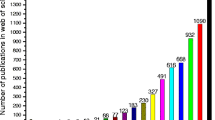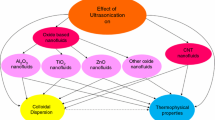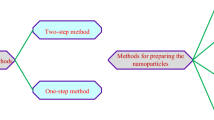Abstract
Using an innovative nanofluid preparation method, ultrasonic-aidedsubmerged arc nanoparticle synthesis system, this paper employs the robustness design method to examine the optimal parameters, such as peak current, pulse duration, open voltage and amplitude of ultrasonic vibration, for obtaining the optimal process for TiO2 nanofluid preparation. Experimental results show that the proposed manufacturing system can successfully prepare uniformly distributed TiO2 nanoparticle using the optimal parameters. The pH of the as prepared TiO2 nanofluid is 7.5, which is much higher than that of isoelectric point, about 4.4. Hence, the suspended TiO2 nanoparticles already possess electrostatic stability properties. Regarding ultraviolet/visible absorbency, the produced TiO2 nanofluid would absorb UV energy when the wavelength is 280 nm to 400 nm. According to the UV-Vis absorption spectrum analysis, the energy band gap of the prepared TiO2 nanoparticle is 3.4 eV.
Similar content being viewed by others
References
Wang R (1997) Light-induced amphiphilic surfaces. Nature 388:431–432
Bekholet M (1997) Photocatalytic bactericidal activity of TiO2 in aqueous suspensions of E. coli. Wat Sci Technol 35(11):95–100
Ogura K, Uchida H, Sasaki T (1994) Dark catalytic reduction of CO2 over Prussian blue-deposited TiO2 and the photo-reactivation of the catalyst. J Molecu Cataly 93(3):269–277
Soni JS (1994) Microanalysis of debris formed during rotary EDM of titanium alloy (Ti 6A1 4V) and die steel (T 215 Cr 12). Wear 17:71–79
Willey P (1975) EDM debris assist investigation into the mechanism of the EDM process. Proc IEE Conf, Electromethods of Machining, Forming and Coating, pp 265–270
Murti VSR, Philip PK (1987) An analysis of the debris in ultrasonic-assisted electrical discharge machining. Wear 117(2):241–250
Tsung TT, Chang H, Chen LC, Han LL, Lo CH, Liu MK (2003) Development of pressure control technique of an Arc-Submerged nanoparticle Synthesis System (ASNSS) for copper nanoparticle fabrication. Mater Trans JIM 44:1138–1142
Chang H, Tsung TT, Chen LC, Yang YC, Lin HM, Han LL, Lin CK (2004) TiO2 Nanoparticle suspension preparation using ultrasonic vibrated assisted arc-submerged nanoparticle synthesis system (ASNSS). Mater Trans JIM 45(3):806–811
Chang H, Tsung TT, Yang YC, Chen LC, Lin HM, Lin CK, Jwo CS (2005) Nanoparticle suspension preparationusing arc spray nanoparticle synthesis system combined with ultrasonic vibration and rotating electrode. Int J Adv Manuf Technol 26:552–558
Tsung TT, Chang H, Chen LC, Liu MK, Lin HM, Lin CK (2004) Process development of a novel arc spray nanoparticle synthesis system (ASNSS) for preparation of TiO2 nanoparticle suspension. Int J Adv Manuf Technol 24:879–885
Atobe M, Nonaka T (1997) Ultrasonic effects on electroorganic processes. Chem Lett 120:323–329
Tsao MS, Kuan CB, Hsu CC (1998) Introduction to Nanomaterials. University of Haerhping, Shenyang, China
Mulvaney P (1998) Zeta potential and colloid reaction kinetics. WILEY-VCH, Weinheim
Yang HG (2000) Inference of pH value for the rheology of the TiO2 nanoparticle suspension. J Chem (Taiwan) 237:50–57
Lee CH (2002) Application of Zeta potential for measuring the nanoparticles. J Indust Mater (Taiwan) 190(10):34–39
Kosacki I, Colomban Ph, Anderson HU (1999) Band gap energy in nanocrystalline ZrO2:16%Y thin films. Appl Phys Lett 74:341–343
Fujii H, Ohtaki M, Eguchi K (1998) Synthesis and photocatalytic activity of lamellar titanium oxide formed by surfactant bilayer templating. J Am Chem Soc 120(27):6832–6833
Author information
Authors and Affiliations
Corresponding author
Rights and permissions
About this article
Cite this article
Chang, H., Jwo, C.S., Fan, P.S. et al. Process optimization and material properties for nanofluid manufacturing. Int J Adv Manuf Technol 34, 300–306 (2007). https://doi.org/10.1007/s00170-006-0597-0
Received:
Accepted:
Published:
Issue Date:
DOI: https://doi.org/10.1007/s00170-006-0597-0




